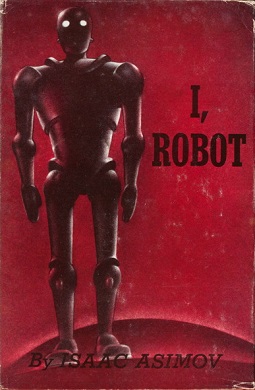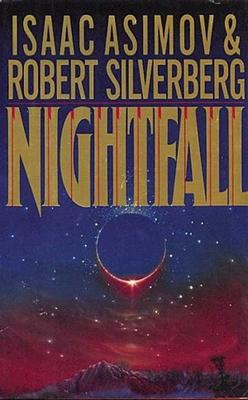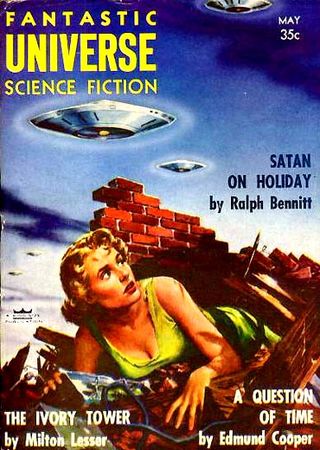
I, Robot is a fixup collection made up of science fiction short stories by American writer Isaac Asimov. The stories originally appeared in the American magazines Super Science Stories and Astounding Science Fiction between 1940 and 1950 and were then collected into a 1950 publication Gnome Press in 1950, in an initial edition of 5,000 copies.

Isaac Asimov was an American writer and professor of biochemistry at Boston University. During his lifetime, Asimov was considered one of the "Big Three" science fiction writers, along with Robert A. Heinlein and Arthur C. Clarke. A prolific writer, he wrote or edited more than 500 books. He also wrote an estimated 90,000 letters and postcards. Best known for his hard science fiction, Asimov also wrote mysteries and fantasy, as well as popular science and other non-fiction.

The Three Laws of Robotics are a set of rules devised by science fiction author Isaac Asimov, which were to be followed by robots in several of his stories. The rules were introduced in his 1942 short story "Runaround", although similar restrictions had been implied in earlier stories.

Gardner Raymond Dozois was an American science fiction author and editor. He was the founding editor of The Year's Best Science Fiction anthologies (1984–2018) and was editor of Asimov's Science Fiction magazine (1986–2004), garnering multiple Hugo and Locus Awards for those works almost every year. He also won the Nebula Award for Best Short Story twice. He was inducted to the Science Fiction Hall of Fame on June 25, 2011.
This is a bibliography of the books written or edited by Isaac Asimov, arranged alphabetically. Asimov was a prolific author, and he engaged in many collaborations with other authors. This list may not yet be complete. The total number of books listed here is over 500. Asimov died in 1992 at age 72; a small number of his books were published posthumously.

"Nightfall" is a 1941 science fiction short story by the American writer Isaac Asimov about the coming of darkness to the people of a planet ordinarily illuminated by sunlight at all times. It was adapted into a novel with Robert Silverberg in 1990. The short story has appeared in many anthologies and six collections of Asimov stories. In 1968, the Science Fiction Writers of America voted "Nightfall" the best science fiction short story written prior to the 1965 establishment of the Nebula Awards and included it in The Science Fiction Hall of Fame Volume One, 1929–1964.

"C-Chute" is a science fiction short story by American writer Isaac Asimov. It was first published in the October 1951 issue of Galaxy Magazine and later appeared in Asimov's collections Nightfall and Other Stories (1969) and The Best of Isaac Asimov (1973).
"The Dying Night" is a science fiction short story by American writer Isaac Asimov. The story first appeared in the July 1956 issue of The Magazine of Fantasy & Science Fiction, and was reprinted in the collections Nine Tomorrows (1959), Asimov's Mysteries (1968), and The Best of Isaac Asimov (1973). "The Dying Night" is Asimov's third Wendell Urth story.

Buy Jupiter and Other Stories is a 1975 collection of short stories by American writer Isaac Asimov. Each story is introduced by a short account of how it came to be written and what was happening in Asimov's life at the time, and follows on from where The Early Asimov (1972) left off. In the introduction, Asimov explains that his objective is to tell enough of his autobiography in his short story collections so that his editors will stop asking him to write an actual autobiography.

"The Gentle Vultures" is a science fiction short story by American writer Isaac Asimov. The story first appeared in the December 1957 issue of Super-Science Fiction, and was reprinted in the 1959 collection Nine Tomorrows.

The Alternate Asimovs (1986) is a collection of early science fiction drafts by American writer Isaac Asimov. Asimov mostly threw away early drafts. Just a few survived and were included in this anthology.
"In a Good Cause—" is a science fiction short story by American writer Isaac Asimov. The story first appeared in a 1951 edition of the anthology New Tales of Space and Time and was reprinted in the collection Nightfall and Other Stories (1969).
"The Hazing" is a science fiction short story by Isaac Asimov. It was first published in the October 1942 issue of Thrilling Wonder Stories and reprinted in the 1972 collection The Early Asimov. Discussing the story in The Early Asimov, the author noted that it is set in the same fictional universe as his earlier stories "Homo Sol" and "The Imaginary", but featured different characters. "The Hazing" was the thirtieth story written by Asimov, and the twenty-eighth to be published. Due to the peculiar workings of the science fiction magazine publishing industry, the story appeared a month before "The Imaginary".
"No Connection" is a science fiction short story by American writer Isaac Asimov. It was first published in the June 1948 issue of Astounding Science Fiction and reprinted in the 1972 collection The Early Asimov.
"Half-Breed" is a science fiction short story by American writer Isaac Asimov. It was first published in the February 1940 issue of Astonishing Stories and reprinted in the 1972 collection The Early Asimov. It was the fifteenth story written by Asimov, and the fourth to be published. At 9000 words, it was his longest published story to date.
"Buy Jupiter!" is a humorous science fiction short story by American writer Isaac Asimov. It was first published in the May 1958 issue of Venture Science Fiction Magazine, and reprinted in the 1975 collection Buy Jupiter and Other Stories. The original title of the story was "It Pays," though it was never published under this name.

"Hell-Fire" is a science fiction short story by American writer Isaac Asimov, originally published in the May 1956 issue of Fantastic Universe and reprinted in the 1957 collection Earth Is Room Enough. It is one of a number of stories, such as "Darwinian Pool Room" and "Silly Asses", in which Asimov worries about the nuclear arms race of the 1950s.
"The Quest for Saint Aquin" is a science fiction short story by the American writer Anthony Boucher, originally published in 1951 in New Tales of Space and Time. "The Quest for Saint Aquin" was among the stories selected in 1970 by the Science Fiction Writers of America as one of the best science fiction short stories published before the creation of the Nebula Awards. As such, it was published in The Science Fiction Hall of Fame Volume One, 1929-1964.
In a writing career spanning 53 years (1939–1992), science fiction and popular science author Isaac Asimov (1920–1992) wrote and published 40 novels, 383 short stories, over 280 non-fiction books, and edited about 147 others.
Depending on the counting convention used, and including all titles, charts, and edited collections, there may be currently over 500 books in Isaac Asimov's bibliography—as well as his individual short stories, individual essays, and criticism. For his 100th, 200th, and 300th books, Asimov published Opus 100 (1969), Opus 200 (1979), and Opus 300 (1984), celebrating his writing.









